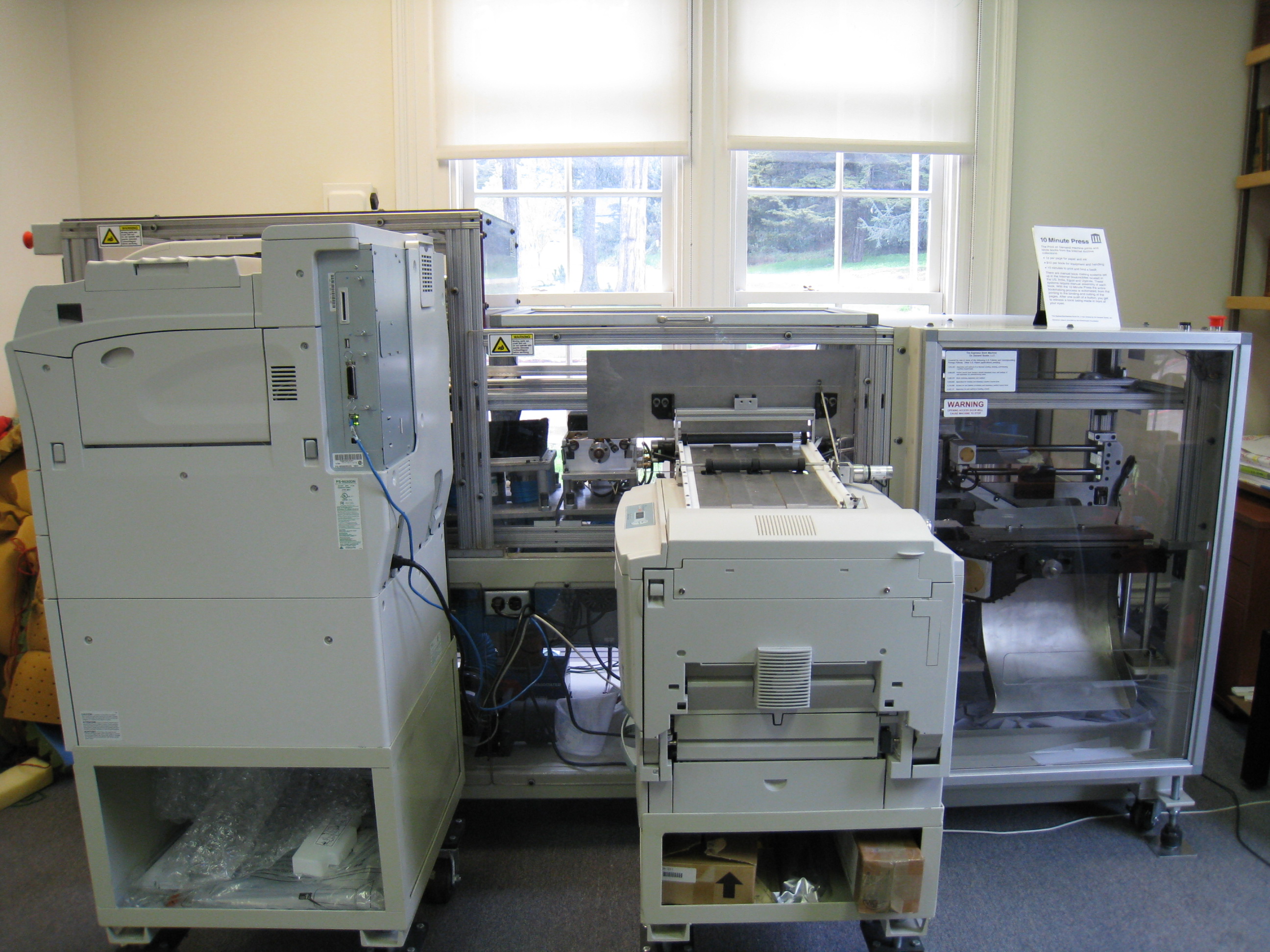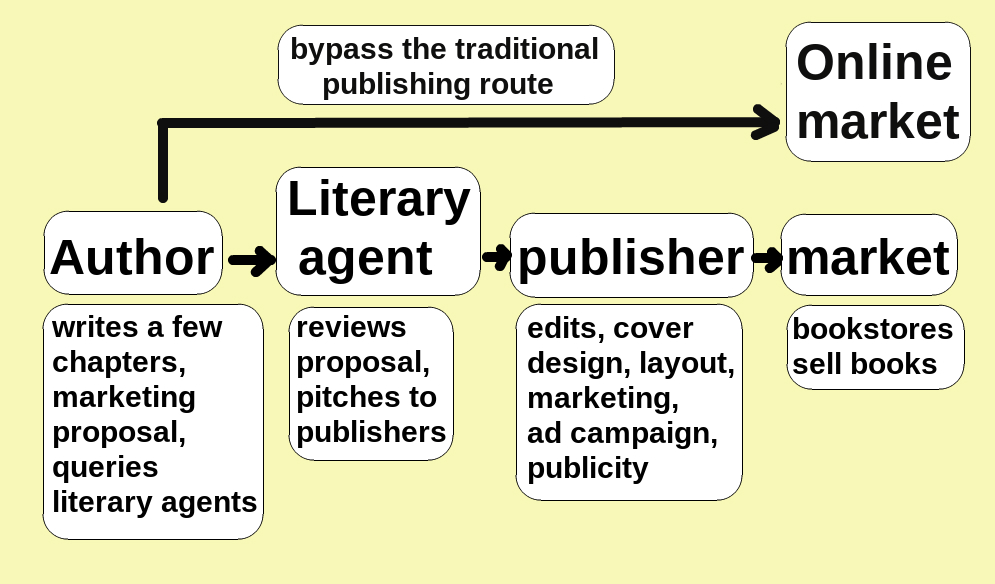|
Print-on-demand
Print on demand (POD) is a printing technology and business process in which book copies (or other documents, packaging or materials) are not printed until the company receives an order, allowing prints of single or small quantities. While other industries established the build to order business model, "print on demand" could only develop after the beginning of digital printing, because it was not economical to print single copies using traditional printing technology such as letterpress and offset printing. Many traditional small presses have replaced their traditional printing equipment with POD equipment or contract their printing to POD service providers. Many academic publishers, including university presses, use POD services to maintain large backlists (lists of older publications); some use POD for all of their publications. Larger publishers may use POD in special circumstances, such as reprinting older, out-of-print titles, or for test marketing. Predecessors Be ... [...More Info...] [...Related Items...] OR: [Wikipedia] [Google] [Baidu] |
Publishing
Publishing is the activity of making information, literature, music, software and other content available to the public for sale or for free. Traditionally, the term refers to the creation and distribution of printed works, such as books, newspapers, and magazines. With the advent of digital information systems, the scope has expanded to include electronic publishing such as ebooks, academic journals, micropublishing, websites, blogs, video game publishing, and the like. Publishing may produce private, club, commons or public goods and may be conducted as a commercial, public, social or community activity. The commercial publishing industry ranges from large multinational conglomerates such as Bertelsmann, RELX, Pearson and Thomson Reuters to thousands of small independents. It has various divisions such as trade/retail publishing of fiction and non-fiction, educational publishing (k-12) and academic and scientific publishing. Publishing is also undertaken by governments, ci ... [...More Info...] [...Related Items...] OR: [Wikipedia] [Google] [Baidu] |
Self-publishing
Self-publishing is the publication of media by its author at their own cost, without the involvement of a publisher. The term usually refers to written media, such as books and magazines, either as an ebook or as a physical copy using POD (print on demand) technology. It may also apply to albums, pamphlets, brochures, games, video content, artwork, and zines. Web fiction is also a major medium for self-publishing. Definitions Although self-publishing is not a new phenomenon, dating back to the 18th century, it has transformed during the internet age with new technologies and services providing increasing alternatives to traditional publishing, becoming a $1 billion market.Jennifer Alsever, Fortune magazine, 30 December 2016The Kindle Effect Retrieved 9 November 2017, "...has become a $1 billion industry..." However, with the increased ease of publishing and the range of services available, confusion has arisen as to what constitutes self-publishing. In 2022, the Society ... [...More Info...] [...Related Items...] OR: [Wikipedia] [Google] [Baidu] |
Galley Proof
In printing and publishing, proofs are the preliminary versions of publications meant for review by authors, editors, and proofreaders, often with extra-wide margins. Galley proofs may be uncut and unbound, or in some cases electronically transmitted. They are created for proofreading and copyediting purposes, but may also be used for promotional and review purposes. Historical galley proofs Proof, in the typographical sense, is a term that dates to around 1600. The primary goal of proofing is to create a tool for verification that the job is accurate. All needed or suggested changes are physically marked on paper proofs or electronically marked on electronic proofs by the author, editor, and proofreaders. The compositor, typesetter, or printer receives the edited copies, corrects and re-arranges the type or the pagination, and arranges for the press workers to print the final or published copies. Galley proofs or galleys are so named because in the days of hand-set let ... [...More Info...] [...Related Items...] OR: [Wikipedia] [Google] [Baidu] |
Punched Cards
A punched card (also punch card or punched-card) is a piece of stiff paper that holds digital data represented by the presence or absence of holes in predefined positions. Punched cards were once common in data processing applications or to directly control automated machinery. Punched cards were widely used through much of the 20th century in the data processing industry, where specialized and increasingly complex unit record machines, organized into semiautomatic data processing systems, used punched cards for data input, output, and storage. The IBM 12-row/80-column punched card format came to dominate the industry. Many early digital computers used punched cards as the primary medium for input of both computer programs and data. While punched cards are now obsolete as a storage medium, as of 2012, some voting machines still used punched cards to record votes. They also had a significant cultural impact. History The idea of control and data storage via punched hole ... [...More Info...] [...Related Items...] OR: [Wikipedia] [Google] [Baidu] |
Mass-market
The term "mass market" refers to a market for goods produced on a large scale for a significant number of end consumers. The mass market differs from the niche market in that the former focuses on consumers with a wide variety of backgrounds with no identifiable preferences and expectations in a large market segment.“Niche Market.” ''Business: The ultimate resource''. (2002). Cambridge, Massachusetts: Perseus Publications:1294. Traditionally, businesses reach out to the mass market with advertising messages through a variety of media including radio, TV, newspapers and the Web. Definition Scholars have noted that defining the precise nature of the mass market is problematic. This difficulty arises, at least in part, from scholarly attention being given to the process of mass marketing rather than the mass market, per se. In addition, the concept of a mass market means different things in different contexts and has evolved over time, adding yet another layer of complexity. Th ... [...More Info...] [...Related Items...] OR: [Wikipedia] [Google] [Baidu] |
Royalties
A royalty payment is a payment made by one party to another that owns a particular asset, for the right to ongoing use of that asset. Royalties are typically agreed upon as a percentage of gross or net revenues derived from the use of an asset or a fixed price per unit sold of an item of such, but there are also other modes and metrics of compensation.Guidelines for Evaluation of Transfer of Technology Agreements, United Nations, New York, 1979 A royalty interest is the right to collect a stream of future royalty payments. A license agreement defines the terms under which a resource or property are licensed by one party to another, either without restriction or subject to a limitation on term, business or geographic territory, type of product, etc. License agreements can be regulated, particularly where a government is the resource owner, or they can be private contracts that follow a general structure. However, certain types of franchise agreements have comparable provisions. ... [...More Info...] [...Related Items...] OR: [Wikipedia] [Google] [Baidu] |
King And McGaw
King & McGaw is an art publisher and online retailer. It supplies high quality art prints and products to museums, galleries and retail stores as well as art prints direct to consumers through its online retail site. Production is based in their factory in Newhaven, Sussex. The company was set up in Sussex in 1982 by three brothers Gyr, Quentin and Perry King under the name King Publishing, as a silkscreen printing company. The company designed upmarket posters for art galleries and small boutique shops. The brothers negotiated the rights to works of art by new artists and photographers, as well as established artists such as Bridget Riley, Howard Hodgkin and Terry Frost. The company rebranded to King Posters by the late 1980s with the business developing into other areas including framing and product development for museum shops such as the Tate, National Gallery, Louvre, Metropolitan Museum of Art and the Museum of Modern Art. In 1989 King Posters was making annual sales o ... [...More Info...] [...Related Items...] OR: [Wikipedia] [Google] [Baidu] |
Inkjet Printer
Inkjet printing is a type of computer printing that recreates a digital image by propelling droplets of ink onto paper and plastic substrates. Inkjet printers were the most commonly used type of printer in 2008, and range from small inexpensive consumer models to expensive professional machines. By 2019, laser printers outsold inkjet printers by nearly a 2:1 ratio, 9.6% vs 5.1% of all computer peripherals. The concept of inkjet printing originated in the 20th century, and the technology was first extensively developed in the early 1950s. While working at Canon in Japan, Ichiro Endo suggested the idea for a "Bubble jet" printer, while around the same time Jon Vaught at HP was developing a similar idea. In the late 1970s, inkjet printers that could reproduce digital images generated by computers were developed, mainly by Epson, Hewlett-Packard (HP) and Canon. In the worldwide consumer market, four manufacturers account for the majority of inkjet printer sales: Canon, HP, Eps ... [...More Info...] [...Related Items...] OR: [Wikipedia] [Google] [Baidu] |
Large-format
Large format refers to any imaging format of or larger. Large format is larger than "medium format", the or size of Hasselblad, Mamiya, Rollei, Kowa, and Pentax cameras (using 120- and 220-roll film), and much larger than the frame of 35 mm format. The main advantage of a large format, film or digital, is a higher resolution at the same pixel pitch, or the same resolution with larger pixels or grains which allows each pixel to capture more light enabling exceptional low-light capture. A 4×5 inch image (12.903 mm²) has about 15 times the area, and thus 15× the total resolution, of a 35 mm frame (864 mm²). Large format cameras were some of the earliest photographic devices, and before enlargers were common, it was normal to just make 1:1 contact prints from a 4×5, 5×7, or 8×10-inch negative. Formats The most common large format is 4×5 inches (10.2x12.7 cm), which was the size used by cameras like the Graflex Speed Graphic and Crown ... [...More Info...] [...Related Items...] OR: [Wikipedia] [Google] [Baidu] |
Ultraviolet
Ultraviolet (UV) is a form of electromagnetic radiation with wavelength from 10 nm (with a corresponding frequency around 30 PHz) to 400 nm (750 THz), shorter than that of visible light, but longer than X-rays. UV radiation is present in sunlight, and constitutes about 10% of the total electromagnetic radiation output from the Sun. It is also produced by electric arcs and specialized lights, such as mercury-vapor lamps, tanning lamps, and black lights. Although long-wavelength ultraviolet is not considered an ionizing radiation because its photons lack the energy to ionize atoms, it can cause chemical reactions and causes many substances to glow or fluoresce. Consequently, the chemical and biological effects of UV are greater than simple heating effects, and many practical applications of UV radiation derive from its interactions with organic molecules. Short-wave ultraviolet light damages DNA and sterilizes surfaces with which it comes into contact. ... [...More Info...] [...Related Items...] OR: [Wikipedia] [Google] [Baidu] |
Line Printer
A line printer prints one entire line of text before advancing to another line. Most early line printers were impact printers. Line printers are mostly associated with unit record equipment and the early days of digital computing, but the technology is still in use. Print speeds of 600 lines per minute (approximately 10 pages per minute) were achieved in the 1950s, later increasing to as much as 1200 lpm. Line printers print a complete line at a time and have speeds in the range of 150 to 2500 lines per minute. The types of line printers are drum printers, band-printers, and chain printers. Other non-impact technologies have also been used, as thermal line printers were popular in the 1970s and 1980s, and some inkjet and laser printers produce output a line or a page at a time. Designs Many impact printers, such as the daisywheel printer and dot matrix printer, used a print head that printed a character then moved on until an entire line was printed. Line printers wer ... [...More Info...] [...Related Items...] OR: [Wikipedia] [Google] [Baidu] |




.jpg)
.jpg)

